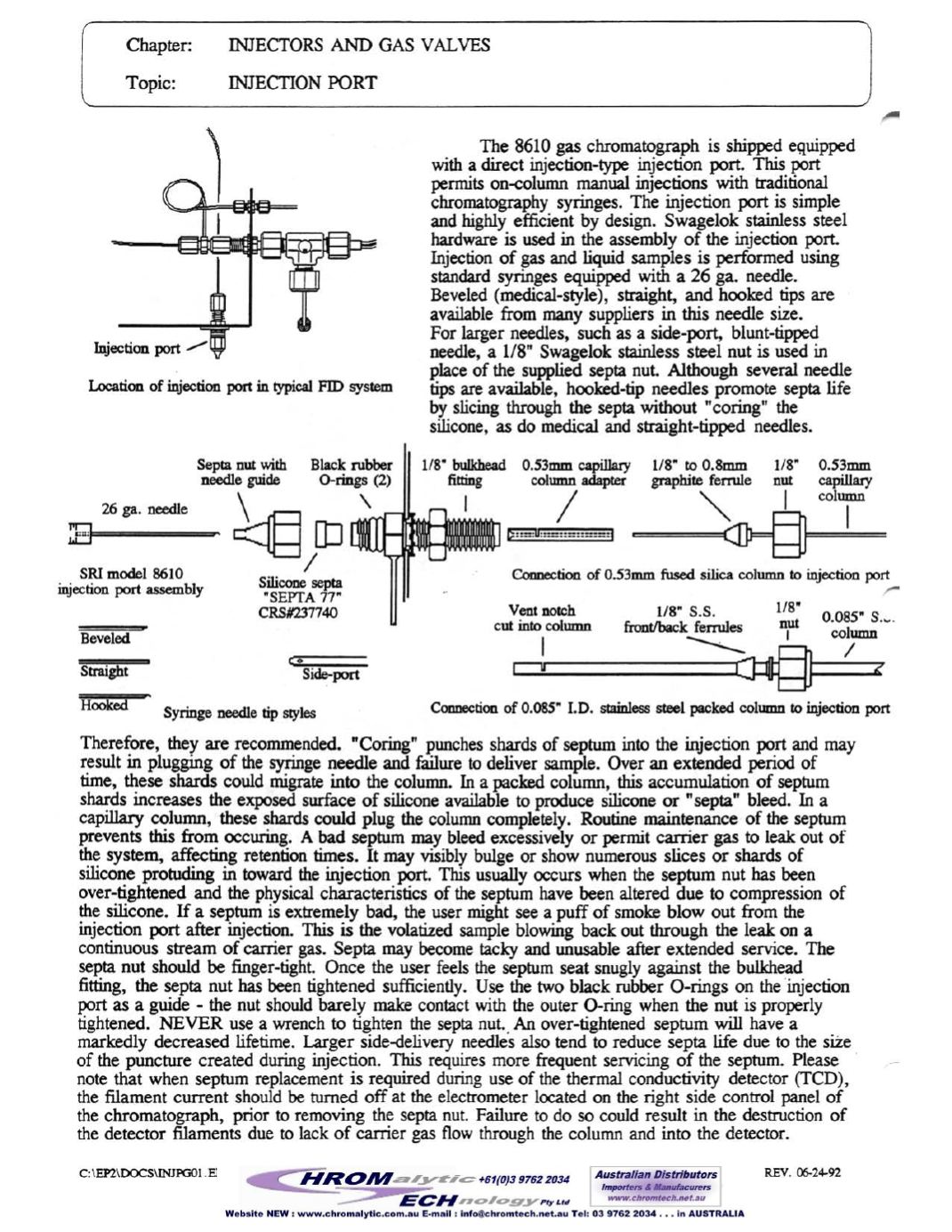
Chapter:
Topic:
INJECTORS ANDGAS VALYES
INJECIlON PORT
Injection
JX)I1 ,.....
Location of injection
port
in
typical
FlO
system.
The 8610 gas chromatograph is shipped equipped
with a
direct
injection-type injection
port.
This
port
permits
on-column manual injections
with
traditional
chromatography syringes. The injection port is simple
andhighly efficient by design. Swagelok stainless steel
hardware is used
in
the assembly of the injection port.
Injectionof gas and liquid samples is performed using
standard syringes equipped witha 26 gao needle.
Beveled (medical-style), straight, and hooked tips are
available from many suppliers in this needle size.
For largerneedles, suchas a side-port, blunt-tipped
needle, a 1/8" Swagelok stainless steel nut is used in
place of the supplied septanut. Although several needle
tips areavailable, hooked-tip needles promote septa life
by slicing
through
the septa without "coring" the
silicone, as domedical andstraight-tipped needles.
SRImodel 8610
injection
port
assembly
26
gao
needle
:EJ- - -
0.53mm.
capillary
column
I
liS-
bulkhead
O.53mmcapillary liS-
to
O.8mm liS-
fitting
column
adaptei
graphite ferrule
nur
I
/
===<~~=
Septa
nUl
with
Black robber
needle
guide
O-rings
(2)
~[lJ
-,
I
Silicooe _
·SEPTA 77–
CRS#237740
Beveled
Stralgbt
Co
Side-port
Hoolred
Syringe
needle
tip
styles
Therefore, they are recommended. "Coring" punches shards of septum intothe injection
port
andmay
result in pluggmg of thesyringe needle and failure todeliver sample. Over an extended period of
time, these shards couldmigrate into thecolumn. Ina packed column,
this
accumulationof septum
shards increases theexposed surface of silicone available toproduce silicone or "septa" bleed. Ina
capillary column, theseshards could plug thecolumn completely. Routine maintenance of theseptum
prevents
this
fromoccuring. Abad
septum
may bleed excessively or permitcarrier
gas
to leakout of
the system, affecting retention times. Itmay visibly bulge orshow numerous slices or shards of
silicone preluding in toward theinjection
port.
Thisusually occurswhen the septumnut hasbeen
over-tightened and thephysical characteristicsof the septum have beenaltereddue tocompression of
the silicone.
If
a
se~tum
is extremely bad, the user
might
see apuff of smoke blowout from the
injection
port
after mjection. This is the volatized sample blowing backout through the leakona
continuous streamofcarrier gas. Septamay become tacky and unusable after extended service. The
septa nut should be finger-tight. Once theuser feels the septum seat snugly against the bulkhead
fitting, the septa nut hasbeen tightened sufficiently. Use the twoblackrubberO-rings on the injection
port as a guide - the nut should barely
make
contact with theouterO-ringwhen the nut is properly
tightened. NEVER useawrench
to
tighten the septa nut.Anover-tightened septum
will
have a
markedly decreased lifetime. Larger side-delivery needles also tend to reduce septa life due
to
the
size
of thepuncture created during injection.
This
requires more frequent servicing of the septum. Please
note that when septum replacement is required during use of the thermal conductivity detector
(TeD) .
the filament current should
be
turned off at the electrometer located on the right side control panel of
the chromatograph. prior to removing the septa nut. Failure todo so could result in the destruction of
the detector filaments due tolack of carriergas flow through the
column
and into thedetector.
C:\EP2\DOCS\lNJPGOI.EPD
REV. Q6..24-92


